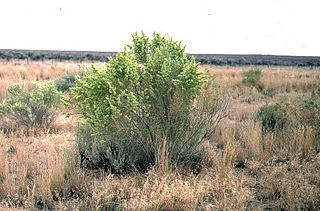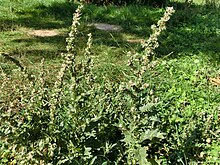
Acorus calamus is a species of flowering plant with psychoactive chemicals. It is a tall wetland monocot of the family Acoraceae, in the genus Acorus. Although used in traditional medicine over centuries to treat digestive disorders and pain, there is no clinical evidence for its safety or efficacy – and ingested calamus may be toxic – leading to its commercial ban in the United States.

Acorus americanus, the American sweet flag, is an emergent wetland plant native to the northern United States and Canada. This perennial plant has bright green blade-shaped leaves that arise directly from the rhizomes and sheath into each other at the base. Additionally the blades have 2-6 raised veins, and a swollen center when viewed in cross section. The foliage has a citrus-like spicy aromatic quality, and can be used to flavor beer. It is a flowering plant with inconspicuous flowers that are arranged on a lateral spadix and the fertilized flowers produce berries with a jelly inside. This plant is protected as a state endangered species in Pennsylvania.

Atriplex canescens is a species of evergreen shrub in the family Amaranthaceae native to the western and midwestern United States.

Atriplex confertifolia, the shadscale or spiny saltbush, is a species of evergreen shrub in the family Amaranthaceae, which is native to the western United States and northern Mexico.

Vaccinium ovatum is a North American species of huckleberry in the heather family commonly known as the evergreen huckleberry, winter huckleberry, cynamoka berry and California huckleberry. It has a large distribution on the Pacific Coast of North America ranging from southern British Columbia to southern California. It is a tall woody shrub that produces fleshy, edible berries in the summer. The plant is used for food, natural landscaping, and floral arrangements.

Mentha canadensis is a species of mint native to North America and the eastern part of Asia. In North America, it is commonly known as Canada mint, American wild mint, and in Asia as Chinese mint, Sakhalin mint, Japanese mint, and East Asian wild mint. The flowers are bluish or have a slight violet tint. The plant is upright, growing to about 4–18 in (10–46 cm) tall. Leaves grow opposite from each other, and flower bunches appear in the upper leaf axils. The mint grows in wet areas but not directly in water, so it will be found near sloughs, and lake and river edges. Plants bloom from July to August in their native habitats.

Turritis glabra, commonly known as tower rockcress or tower mustard, is a tall, slim, grey-green plant with small creamy flowers at the top of the stem. It usually grows on poor chalky or sandy soils, in open situations. It is native to Europe, Asia, and North Africa, and it is widespread in North America where it is also probably native. It can be found in many other parts of the world as an introduced species.

Atriplex cinerea, commonly known as grey saltbush, coast saltbush, barilla or truganini, is a plant species in the family Amaranthaceae. It occurs in sheltered coastal areas and around salt lakes in the Australian states of Western Australia, South Australia, Tasmania, Victoria and New South Wales. The species is also known to be present in the Waimea inlet in New Zealand, although has historically been found in Boulder Bank, D'Urville Island, and Palliser Bay.

Atriplex hortensis, known as garden orache, red orache or simply orache, mountain spinach, French spinach, or arrach, is a species of plant in the amaranth family used as a leaf vegetable that was common before spinach and still grown as a warm-weather alternative to that crop. For many years, it was classified in the goosefoot family, but it has now been absorbed into the Amaranthaceae. It is Eurasian, native to Asia and Europe, and widely naturalized in Canada, the United States, Australia, and New Zealand.

Asplenium septentrionale is a species of fern known by the common names northern spleenwort and forked spleenwort. It is native to Europe, Asia and western North America, where it grows on rocks. Its long, slender leaves give it a distinctive appearance. Three subspecies exist, corresponding to a tetraploid and a diploid cytotype and their triploid hybrid.

Symphyotrichum defoliatum is a species of flowering plant in the family Asteraceae known by the common name San Bernardino aster. It is endemic to Southern California where it grows in grasslands and meadows, and it is of conservation concern.
Atriplex parishii is an uncommon species of saltbush known by the common names Parish's saltbush and Parish's brittlescale. It is native to central and southern California where it can occasionally be found along the immediate coastline, and the Channel Islands. Its distribution extended historically into the western edges of the Mojave Desert and Baja California and it may still exist there.

Tripsacum dactyloides, commonly called eastern gamagrass, or Fakahatchee grass, is a warm-season, sod-forming bunch grass. It is widespread in the Western Hemisphere, native from the eastern United States to northern South America. Its natural habitat is in sunny moist areas, such as along watercourses and in wet prairies. In some areas, it has adapted well to disturbed conditions.

Atriplex gardneri is a species of flowering plant in the amaranth family known by the common name Gardner's saltbush. It is native to western North America from British Columbia to Saskatchewan in Canada south to Nevada and New Mexico in the United States. The specific epithet of the species, gardneri, is misnamed after its first collector, Alexander Gordon. The naturalist Alfred Moquin-Tandon was under the impression that Gordon's last name was Gardner.

Vaccinium pallidum is a species of flowering plant in the heath family known by the common names hillside blueberry, Blue Ridge blueberry, late lowbush blueberry, and early lowbush blueberry. It is native to central Canada (Ontario) and the central and eastern United States plus the Ozarks of Missouri, Arkansas, southeastern Kansas and eastern Oklahoma.

Symphyotrichum lanceolatum is a species of flowering plant in the family Asteraceae native to North America. Common names include panicled aster, lance-leaved aster, and white panicled aster. It is a perennial, herbaceous plant that may reach 1.5 meters tall or more, sometimes approaching 2 m. The lance-shaped leaves are generally hairless but may feel slightly rough to the touch on the top because of tiny bristles. The flowers grow in clusters and branch in panicles. They have 16–50 white ray florets that are up to 14 millimeters long and sometimes tinged pink or purple. The flower centers consist of disk florets that begin as yellow and become purple as they mature.

Halimione is a plant genus from the subfamily Chenopodioideae of the family Amaranthaceae. It is a sister genus of Atriplex and is included in that genus by Plants of the World Online.
Iris ivanovae is a plant species in the genus Iris and part of the subgenus Iris and in the section Pseudoregelia. It is a rhizomatous perennial, from eastern Russia, China, and Mongolia.

Atriplex stipitata, commonly known as mallee saltbush, bitter saltbush and kidney saltbush, is a species of shrub in the family Amaranthaceae, found in all mainland states of Australia.

Symphyotrichum spathulatum is a species of flowering plant in the family Asteraceae native to western North America including northwestern Mexico. Commonly known as western mountain aster, it is a perennial, herbaceous plant that may reach 20 to 80 centimeters tall. Its flowers, which open in July and August, have violet ray florets and yellow disk florets.

















